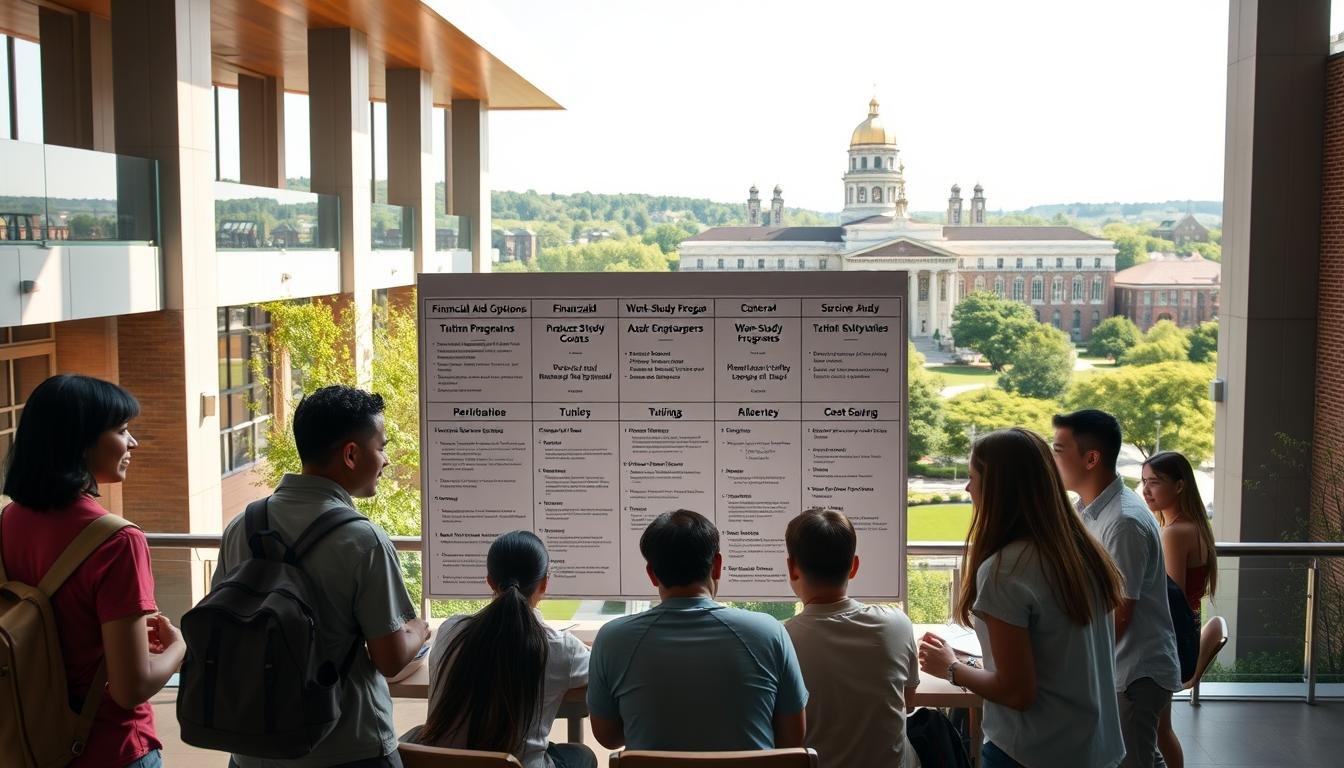The cost of going to Purdue University changes a lot based on where you live. For example, in-state students pay $9,992 in tuition. On the other hand, out-of-state students have to pay $28,794. This big difference shows how important it is to know who can get in-state tuition.

Being an in-state student can save a lot of money. It’s key for students to understand the eligibility requirements. If they meet these, they can pay less for their education. This makes going to school more affordable.
Key Takeaways
- Significant tuition difference between in-state and out-of-state students at Purdue.
- In-state tuition is $9,992, while out-of-state tuition is $28,794.
- Understanding eligibility criteria is key for in-state tuition benefits.
- Meeting specific requirements can lead to big savings.
- In-state classification makes education more affordable for students.
Understanding Purdue’s Tuition Structure
Residency status is key in figuring out Purdue University’s tuition rates. Knowing the difference between in-state and out-of-state tuition is important. It affects how much students have to pay.
In-State vs. Out-of-State Tuition Rates
Purdue University has different tuition rates for in-state and out-of-state students. This difference is big. In-state students pay $9,992, while out-of-state students pay $28,794.
This shows how important it is to know about Purdue in-state tuition qualifications. Also, understanding how to establish residency is vital.
Financial Impact of Residency Status
Being an in-state student has a big financial advantage. Qualifying for in-state tuition can greatly reduce costs. It makes going to college more affordable and helps avoid a lot of debt.
Annual Savings with In-State Classification
Being classified as in-state can save students a lot of money each year. The difference in tuition between in-state and out-of-state students is $18,802 annually. This savings is a big factor in deciding where to go to college.
Purdue University In-State Tuition Requirements
Knowing the in-state tuition rules at Purdue University is key for students wanting to save money. To get in-state tuition, students must show they live in Indiana. They also need to be enrolled in the semester they apply for this status.
Overview of Residency Classification
At Purdue University, being a resident means you live there permanently. The school looks at many things to see if you really live in Indiana.
Basic Eligibility Criteria
To get in-state tuition, students must prove they live in Indiana. They need to show they live there, plan to stay, and are financially independent.
Recent Changes to Residency Policies
Purdue University updates its residency rules from time to time. The latest changes make it clearer what documents you need to prove you live in Indiana. They also made the rules for financial independence stricter.
Who Qualifies Automatically for In-State Rates
Some people automatically get in-state tuition at Purdue. This includes kids of Indiana residents, military people stationed there, and those who have become permanent residents of the U.S. and live in Indiana.
| Category | Eligibility Criteria | Documentation Required |
| Dependent Children | Children of Indiana residents | Parent’s Indiana driver’s license, tax returns |
| Military Personnel | Stationed in Indiana | Military ID, orders showing Indiana station |
| Permanent Residents | Granted permanent residency, domicile in Indiana | Green card, Indiana utility bills |
Establishing Indiana Residency for Tuition Purposes
To get in-state tuition at Purdue University, you need to show you live in Indiana. You must prove you plan to stay and are financially independent. Meeting these criteria helps you qualify for lower tuition rates.
Physical Presence Requirements
Living in Indiana for a long time is key to showing you’re a resident. It’s not just about visiting. Physical presence is a critical factor in determining residency status.
Duration of Residency Needed
To qualify for in-state tuition, you must live in Indiana for at least 12 months before classes start. This shows you have a strong connection to the state.
Intent to Remain in Indiana
Showing you plan to stay in Indiana is important. You can prove this by buying a home, voting, or getting an Indiana driver’s license. These actions show you’re committed to the state.
Financial Independence Considerations
Being financially independent is also important. If you’re not relying on your parents for money, you might be considered a resident. This means you’re self-sufficient and not dependent on out-of-state income.
Employment Requirements
Working in Indiana can help prove you’re a resident. Having a job shows you’re committed to staying in the state. It also helps with your financial independence. This is important when applying for in-state tuition.
By understanding and meeting these requirements, students can establish Indiana residency. This leads to lower in-state tuition rates at Purdue University.
Step-by-Step Guide to Applying for In-State Tuition
Students looking to cut their tuition costs need to know about Purdue’s in-state tuition process. This process has several steps to make sure students qualify for in-state tuition. Each step is important for the right tuition classification.
Creating Your Residency Application Account
The first step is to make a residency application account on Purdue’s website. This account is your gateway for submitting information and tracking your application. You’ll need to give basic details like your name, Purdue ID, and contact info to set it up.
Completing the Residency Classification Form
After setting up your account, you must fill out the Residency Classification Form. This form asks about your residency in Indiana, your plans to stay, and other important details. It’s key to answer this form carefully to avoid delays.

Submitting Supporting Documentation
You also need to provide documents to prove you’re eligible for in-state tuition. This includes things like utility bills, lease agreements, and work records. Make sure these documents are current and show you live in Indiana.
Following Up on Your Application
After you’ve applied and sent in your documents, keep an eye on your application’s status. You can check your account or contact Purdue’s Residency Affairs office. Staying in touch can help your application get processed faster.
Key Deadlines for Maximum Savings
To save the most money, know the important deadlines for in-state tuition. These deadlines change with each semester or year. Always check Purdue’s website for the latest info. If you miss these deadlines, you might have to pay out-of-state tuition.
Key Takeaways:
- Create a residency application account on Purdue’s website.
- Complete the Residency Classification Form accurately.
- Submit all required supporting documentation.
- Follow up on your application status regularly.
- Be aware of key deadlines to maximize your savings.
Essential Documentation for Proving Indiana Residency
To get in-state tuition at Purdue University, you need the right documents. The university wants proof of your Indiana residency. Knowing what they need is important for a successful application.
Primary Documentation Requirements
To show you live in Indiana, you need primary documents. Proof of physical presence includes an Indiana driver’s license or state ID, utility bills, or lease agreements. These must have your name and Indiana address.
Intent to remain in Indiana can be shown with employment records, voter registration, or Indiana state income tax returns. It’s important to have documents that show both physical presence and intent.
Secondary Supporting Documents
You might also need secondary documents to support your residency claim. These include:
- Bank statements showing transactions in Indiana
- Employment records or pay stubs
- Voter registration card
- Indiana vehicle registration
- Proof of membership in local organizations or clubs
These documents help show your strong ties to Indiana.
Documentation Organization Tips
Organizing your documents well is key for a smooth application. Here are some tips:
- Make digital copies of all documents to keep for your records
- Use clear labels for each document, indicating its purpose
- Arrange documents in the order requested by the university
- Double-check that all documents are up-to-date and valid
Organizing your documents carefully can prevent delays in your application.
Common Documentation Mistakes to Avoid
When applying, watch out for common mistakes that can cause delays or rejection. These include:
- Submitting incomplete or expired documents
- Failing to provide a clear link between documents and the information claimed
- Not following the university’s specific guidelines for document submission
By avoiding these mistakes, your application will be processed smoothly.
Common Pitfalls When Seeking In-State Status
Understanding Purdue’s residency guidelines is key to avoid common mistakes. These mistakes can lead to not getting in-state tuition. Many students struggle with the complex rules for residency.

Misunderstanding the 12-Month Rule
One big mistake is not understanding the 12-month residency rule. Students think living in Indiana for 12 months means they get in-state tuition. But, the university looks for continuous physical presence and a clear intent to stay.
Failing to Establish Financial Independence
Another common issue is not showing financial independence. Students who are claimed as dependents on someone else’s taxes struggle to prove they are financially independent. This is a big factor in residency status.
Insufficient Documentation of Intent
Not having enough proof of staying in Indiana can also block your application. You need to show clear evidence, like lease agreements and employment records. This proves you really plan to stay in the state.
Out-of-State Ties That Can Disqualify You
Having ties to another state, like an out-of-state driver’s license, can stop you from getting in-state tuition. It’s important to cut these ties and make Indiana your main home.
Knowing these common mistakes and how to avoid them can help students get Purdue in-state tuition qualifications. It’s important to review the residency rules carefully and make sure you meet all the requirements. This makes the application process smoother.
Special Cases and Exceptions
Purdue University has rules for in-state tuition that apply to most students. But, there are special cases where these rules don’t apply. These exceptions can change how much students pay for tuition.
Military Personnel and Veterans
Students who are in the military or veterans might get special tuition rates. If you’re on active duty in Indiana or using GI Bill benefits, you could pay in-state tuition. You’ll need to show your military status and proof of living in Indiana.
Dependent Children of Indiana Residents
If your parents moved out of state but were Indiana residents, you might get in-state tuition. You’ll need to show your parents’ tax returns and proof they lived in Indiana.
Reciprocity Agreements with Neighboring States
Purdue has deals with some states that let students pay less tuition. For example, students from Illinois or Michigan might get a break on tuition.
Graduate Student Considerations
Grad students have different rules for in-state tuition. Some programs might have special rules, like for students who work in Indiana or have ties to the state.
International Students with Permanent Residency
International students with permanent residency might get in-state tuition if they live in Indiana. You’ll need to show you’ve lived in Indiana for a while and plan to stay.
| Category | Eligibility Criteria | Required Documentation |
| Military Personnel/Veterans | Active duty in Indiana or using GI Bill benefits | Military ID, orders, GI Bill documents |
| Dependent Children | Parents were Indiana residents | Parent’s tax returns, proof of residency |
| Reciprocity Agreements | Residents of participating states | Proof of residency in participating state |
| Graduate Students | Varies by program; often employment in Indiana | Employment records, proof of Indiana ties |
| International Students with Permanent Residency | Permanent residency and Indiana residency | Green card, proof of Indiana residency |
Alternative Ways to Reduce Tuition Costs at Purdue
There are many ways to lower tuition costs at Purdue. Getting in-state residency is a big help. But, there are other paths for those not eligible for in-state rates.
Scholarships and Grants for Non-Residents
Purdue University has scholarships and grants for non-resident students. These can be based on merit or need. Some are even for international students.
Work-Study Programs
Work-study programs are another option. Students can work part-time on or off campus. This way, they earn money and gain work experience.
Tuition Assistance Programs
Purdue also has tuition assistance programs. These can lessen the financial load. They might come from the university or outside partners.
Online and Satellite Campus Options
Some might find online or satellite campus options appealing. Purdue offers these for flexibility and possibly lower costs.
| Cost-Saving Option | Description | Potential Savings |
| Scholarships and Grants | Merit-based or need-based financial aid | Up to $10,000 per year |
| Work-Study Programs | Part-time work on or off campus | $3,000 – $5,000 per year |
| Tuition Assistance Programs | University or externally funded programs | Varies |
| Online and Satellite Campus | Flexible program options | Up to 20% off traditional tuition |

Exploring these options can make Purdue University more affordable. Students can find ways to cut their tuition costs.
Conclusion
To get the most out of their education, students need to know about Purdue’s in-state tuition rules. It’s key for those looking to cut down on college costs.
Getting Indiana residency for tuition means showing you live there, plan to stay, and are financially independent. By doing these things, students can save a lot on tuition.
| Residency Status | Tuition Rate | Annual Savings |
| In-State | Lower | Significant |
| Out-of-State | Higher | Minimal |
In short, knowing about Purdue in-state tuition can save students a lot of money. By following the steps in this article, students can make smart choices about their education at Purdue University.
Sources
For more information on Purdue University’s in-state tuition requirements, you can refer to the following official sources:
- Purdue University Official Website
- Purdue University Tuition and Fees
- Purdue University Financial Aid
- Purdue University Residency Classification
These resources give detailed info on who qualifies, how to apply, and what documents you need for in-state tuition at Purdue University.
FAQ
What are the basic eligibility criteria for Purdue’s in-state tuition?
To get in-state tuition at Purdue, you need to meet certain requirements. You must live in Indiana, plan to stay, and be financially independent.
How long do I need to be a resident of Indiana to qualify for in-state tuition at Purdue?
Students must live in Indiana for at least 12 months before classes start. This is to qualify for in-state tuition.
What documentation is required to prove Indiana residency for tuition purposes?
To show you live in Indiana, you need a driver’s license or state ID. You also need utility bills or a lease to prove you plan to stay.
Can military personnel and veterans qualify for in-state tuition at Purdue?
Yes, military and veterans might get in-state tuition at Purdue. This includes being stationed in Indiana or having an honorable discharge.
How do I apply for in-state tuition at Purdue?
To apply for in-state tuition, create a residency account. Then, fill out the residency form and submit your documents to prove you live in Indiana.
What are the key deadlines for applying for in-state tuition at Purdue?
Check the Purdue University website for application deadlines. They can change based on the semester or year.
Can international students with permanent residency qualify for in-state tuition at Purdue?
Yes, international students with permanent residency can get in-state tuition at Purdue. They must meet the residency requirements, like living in Indiana.
Are there alternative ways to reduce tuition costs at Purdue beside in-state tuition?
Yes, Purdue has other ways to lower tuition costs. This includes scholarships, grants, work-study, and online or satellite campus options.
How can I ensure my application for in-state tuition is complete and accurate?
To make sure your application is right, review the residency rules. Gather all needed documents and follow Purdue’s application steps.
What are the most common pitfalls when seeking in-state status at Purdue?
Common mistakes include not understanding the 12-month rule, not showing financial independence, and not providing enough proof of staying in Indiana.
